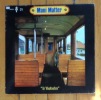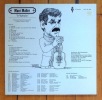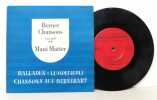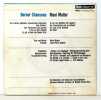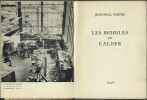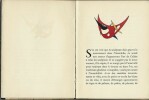193 books for « matter »Edit
-
Latest
Last 3 days (2)
Last month (1)
-
Language
English (1)
French (192)
-
Century
19th (25)
20th (78)
21st (27)
-
Countries
Belgium (13)
Canada (1)
Denmark (6)
France (148)
Switzerland (25)
-
Syndicate
ALAC (1)
CLAM (3)
ILAB (109)
NVVA (6)
SLACES (6)
SLAM (90)
SNCAO (6)
Topics
- Alsace (18)
- Artists (1)
- Autographs (1)
- Bank - stock exchange (2)
- Bible (2)
- Bibliography (3)
- Biography (8)
- Children’s books (53)
- Christianity (1)
- Collections (2)
- Comic strip (2)
- Curiosa (1)
- Dedication (1)
- Discovery (3)
- Education (2)
- Esotericism (4)
- Ethic (3)
- Ex-libris (1)
- Fine arts (2)
- First edition (2)
- Freemasons (1)
- French speaking swiss literature (2)
- Games toys (2)
- Genealogy (3)
- Geography (1)
- Germany (2)
- Hachette (1)
- Helvética (5)
- History (18)
- Honegger (1)
- Israel samuel (1)
- Italy (1)
- Jacob (2)
- Jerusalem (1)
- Language (1)
- Leisure (2)
- Linguistics (1)
- Literature (5)
- London (1)
- Lorrain (7)
- Love (1)
- Mahler gustave (1)
- Mariology (1)
- Masonry (1)
- Monographs (1)
- Music (11)
- Musicology (1)
- Nazism (1)
- Nietzsche frédéric (1)
- Occult (1)
- Paris (1)
- Philosophy (9)
- Photography (1)
- Physics (2)
- Policy (2)
- Psychology (1)
- Reading vocabulary (3)
- Religions (1)
- Religions & spirituality (1)
- Reviews (1)
- Revue de l'art (1)
- Sartre jean paul (1)
- School (2)
- Sociology (1)
- Soul (1)
- Sportsmen (1)
- State (1)
- Switzerland (6)
- Tea (6)
- Teaching (1)
- Theatre (1)
- Theology (3)
- Various (3)
- View (1)
- Wagner richard (1)
- Wairy louis-constant alias constant (1)
- War (4)
- Waves (1)
- Youth (1)
Bernhard Matter, geboren zu Muhen (Aargau) 1822. Vom H. Aargauischen Obergericht unterm 3. Mai 1854 zum Tode verurteilt und den 24. Mai in Lenzburg hingerichtet. Darstellung seines Lebens mit Zugrundlegung der bezüglichen Akten. Mit Matters wohlgetroffenem Portrait.
Aarau, Druck und Verlag von J.J. Christen. 1854. 8°. Frontispiz, 40 S. Originalbroschur.
«Bernhard Matter (21.2.1821-24.5.1854) liess sich 1850 in päpstl. Dienste anwerben, desertierte aber nach wenigen Tagen. Ein Versuch, im selben Jahr nach Amerika auszuwandern, schlug fehl. Als 16-Jähriger musste er erstmals wegen Diebstahls eine vierwöchige Gefängnisstrafe absitzen, danach wurde er wiederholt wegen Diebstahls, Schmuggels und Einbruchs verhaftet, konnte aber mehrmals ausbrechen und erwarb sich damit Popularität. 1854 wurde er in Lenzburg wegen Diebstahls als letzte Person im Kt. Aargau öffentlich enthauptet. Seine Hinrichtung löste heftige Diskussionen aus, die 1857 in eine neue Strafprozessordnung mündeten. Gleichzeitig wurde eine Reform des Gefängniswesens in Angriff genommen, deren Resultat 1864 der Bau der als fortschrittlich geltenden Strafanstalt Lenzburg war.» (HLS). - «Wär da alles mir verwandt isch Han i gluegt, us Quelle gschöpft Numen Eine wo bekannt isch Worde git's: Dä hei si gchöpft!» (Mani Matter: Bärnhard Matter). - Etwas eselsohrig. Stockfleckig. - Selten.
GIACOMETTI (Alberto)]. MATTER (Herbert).
Reference : 103896
(1987)
ISBN : 9780810909991
Alberto Giacometti, photographed by Herbert Matter.
New York Harry N. Abrams 1987 1 vol. relié in-4, cartonnage sous jaquette illustrée, 224 pp., nombreuses photos en noir et en couleurs par Herbert Matter (1907-1984). Textes en anglais par Mercedes Matter, Louis Finkelstein et Andrew Forge. Très bon état.
"BROGLIE (DEBROGLIE), LOUIS de. - DISCOVERY OF THE WAVE THEORY OF MATTER AND CREATION OF WAVE-MECHANICS.
Reference : 46949
(1923)
Ondes et quanta. Note de M. Louis de Broglie, présentée par M. Jean Perrin. (Séance du 10 Septembre 1923). (+) Quanta de lumière, diffraction et interférences. Note de M. Louis de Broglie, transmise par M. Jean Perrin. (Séance du 24 Septembre 1923). (...
Paris, Gauthier-Villars et Cie, 1923. 4to. Bound in 2 contemp. full cloth. Spines gilt and with gilt lettering. In: ""Comptes Rendus Hebdomadaires des Séances de L'Academie des Sciences"", Tome 177. With htitle a. titlepage. 1513 pp. (Entire volume offered). De Broglie's papers: pp. 507-510, pp. 548-551 a. pp. 630-32. Clean and fine. A stamp to verso of titlepage.
First edition of these papers which ESTABLISHED A NEW ERA IN PHYSICS by introducing the epochal new principle that particle-wave duality should apply not only to radiation but also to matter and thus CREATING QUANTUM MECHANICS. These 3 papers were extended to form his doctoral thesis of 1924 ""Recherches sur la Théorie des Quanta.""De Broglie relates ""After long reflection in solitude and meditation, I suddenly had the idea, during the year 1923, that the discovery made by Einstein in 1905 should be generalized by extending it to all material particles and notably to electrons"" (Preface to his PhD thesis 1924).""He made the leap in his September 10, 1923, paper: E=hv should hold not only for photons but also for electrons, to which he assigns a 'fictitious associated wave'. In his September 24 paper, he indicated the direction in which one 'should seek experimental confirmations of our ideas': a stream of electrons traversing an aperture whose dimensions are small compared with the wavelenght of the electron waves 'should show diffraction phenomena' .""(Pais ""Subtle is the Lord"", pp. 425-436).In the third paper (October 8) he discusses ""The interplay between the propagation of the particle and of the waves could be expressed in more formal terms as an identity between the fundamental variational principles of Pierre de Fermat (rays), and Pierre Louis Maupertuis (particles) as de Broglie discussed it further in his last communication . Therein he also considered some thermodynamic consequences of his generalized wave-particle duality. He showed in particular how one could, using Lord Rayleigh’s 1900 formula for the number of stationary modes for phase waves, obtain Planck’s division of the mechanical phase space into quantum cells.Louis de Broglie achieved a worldwide reputation for his discovery of the wave theory of matter, for which he received the Nobel Prize for physics in 1929. His work was extended into a full-fledged wave mechanics by Erwin Schrödinger and thus contributed to the creation of quantum mechanics. After an early attempt to propose a deterministic interpretation of his theory, de Broglie joined the Copenhagen school’s mainstream noncausal interpretation of the quantum theory.""(DSB).""This idea [i.e. de Broglie's that matter might behave as waves] was tested and confirmed by Davisson and Germer in 1927... Thus the duality of both light and matter had been established, and physicists had to come to terms with fundamental particles which defied simple theories and demanded two sets of 'complementary' descriptions, each applicable under certain circumstances, but incompatible with one another."" (Printing and the Mind of Man, 417).
"BROGLIE (DE BROGLIE), LOUIS DE . - DISCOVERY OF THE WAVE THEORY OF MATTER AND CREATION OF WAVE-MECHANICS
Reference : 49718
(1923)
Ondes et quanta. Note de M. Louis de Broglie, présentée par M. Jean Perrin. (Séance du 10 Septembre 1923). (+) Quanta de lumière, diffraction et interférences. Note de M. Louis de Broglie, transmise par M. Jean Perrin. (Séance du 24 Septembre 1923). (...
Paris, Gauthier-Villars et Cie, 1923. 4to. Bound in one contemp. full buckram. Spines gilt and with gilt lettering. In: ""Comptes Rendus Hebdomadaires des Séances de L'Academie des Sciences"", Tome 177. Bound with orig. printed front-wrapper to No. 1, half-title and title-page to vol. 177. 1513 pp. (Entire volume offered). De Broglie's papers: pp. 507-510, pp. 548-551 a. pp. 630-32. Clean and fine. A punched stamp on foot of title-page.
First edition of these papers which ESTABLISHED A NEW ERA IN PHYSICS by introducing the epochal new principle that particle-wave duality should apply not only to radiation but also to matter and thus CREATING QUANTUM MECHANICS. These 3 papers were extended to form his doctoral thesis of 1924 ""Recherches sur la Théorie des Quanta.""De Broglie relates ""After long reflection in solitude and meditation, I suddenly had the idea, during the year 1923, that the discovery made by Einstein in 1905 should be generalized by extending it to all material particles and notably to electrons"" (Preface to his PhD thesis 1924).""He made the leap in his September 10, 1923, paper: E=hv should hold not only for photons but also for electrons, to which he assigns a 'fictitious associated wave'. In his September 24 paper, he indicated the direction in which one 'should seek experimental confirmations of our ideas': a stream of electrons traversing an aperture whose dimensions are small compared with the wavelenght of the electron waves 'should show diffraction phenomena' .""(Pais ""Subtle is the Lord"", pp. 425-436).In the third paper (October 8) he discusses ""The interplay between the propagation of the particle and of the waves could be expressed in more formal terms as an identity between the fundamental variational principles of Pierre de Fermat (rays), and Pierre Louis Maupertuis (particles) as de Broglie discussed it further in his last communication . Therein he also considered some thermodynamic consequences of his generalized wave-particle duality. He showed in particular how one could, using Lord Rayleigh’s 1900 formula for the number of stationary modes for phase waves, obtain Planck’s division of the mechanical phase space into quantum cells.Louis de Broglie achieved a worldwide reputation for his discovery of the wave theory of matter, for which he received the Nobel Prize for physics in 1929. His work was extended into a full-fledged wave mechanics by Erwin Schrödinger and thus contributed to the creation of quantum mechanics. After an early attempt to propose a deterministic interpretation of his theory, de Broglie joined the Copenhagen school’s mainstream noncausal interpretation of the quantum theory.""(DSB).""This idea [i.e. de Broglie's that matter might behave as waves] was tested and confirmed by Davisson and Germer in 1927... Thus the duality of both light and matter had been established, and physicists had to come to terms with fundamental particles which defied simple theories and demanded two sets of 'complementary' descriptions, each applicable under certain circumstances, but incompatible with one another."" (Printing and the Mind of Man, 417).
"BROGLIE, LOUIS de. - DISCOVERY OF THE WAVE THEORY OF MATTER AND CREATION OF WAVE-MECHANICS.
Reference : 46950
(1924)
A Tentative Theory of Light Quanta.
London, Taylor and Francis, 1924. Later full buckram, gilt lettering to spine. In: Philosophical Magazine conducted by Oliver Joseph Lodge etc."", Vol. 47. - Sixth Series. VIII,1168 pp. and 8 plates. (Entire volume offered). De Broglie's paper: pp. 446-458. Internally clean and fine.
First English version of the papers which ESTABLISHED A NEW ERA IN PHYSICS by introducing the epochal new principle that particle-wave duality should apply not only to radiation but also to matter and thus CREATING QUANTUM MECHANICS. The English paper is a translation of de Broglie's 3 ""Notes "" which he published in ""Comptes Rendus"" in September and October 1923 (Ondes et quanta. - Quanta de lumière, diffraction et interférences. - Les quanta, la théorie cinétique des gaz et le principe de Fermat). These 3 papers were extended to form his doctoral thesis of 1924 ""Recherches sur la Théorie des Quanta."" - This English edition (of the papers) was published before his thesis of 1924 as the paper is dated October 1, 1923, and published here in the Februar issue of Philosophical Magazine, months before the thesis.The English version contains furthermore an addition, a postscript, which contains a generalization of the theory which is consistent with the special theory of relativity, and NOT published in ""Comptes Rendues"" in 1923.With the three communications to the Academy of Sciences (the 3 Comptes Rendus papers) in the fall of 1923 de Broglie had presented the main ideas of his unified dynamics of light quanta and atoms. He was confident enough about his results that he submitted them also in English in the offered paper. At the end of the paper he summarized his results. De Broglie relates ""After long reflection in solitude and meditation, I suddenly had the idea, during the year 1923, that the discovery made by Einstein in 1905 should be generalized by extending it to all material particles and notably to electrons"" (Preface to his PhD thesis 1924).""He made the leap in his September 10, 1923, paper: E=hv should hold not only for photons but also for electrons, to which he assigns a 'fictitious associated wave'. In his September 24 paper, he indicated the direction in which one 'should seek experimental confirmations of our ideas': a stream of electrons traversing an aperture whose dimensions are small compared with the wavelenght of the electron waves 'should show diffraction phenomena' .""(Pais ""Subtle is the Lord"", pp. 425-436).In the third paper (October 8) he discusses ""The interplay between the propagation of the particle and of the waves could be expressed in more formal terms as an identity between the fundamental variational principles of Pierre de Fermat (rays), and Pierre Louis Maupertuis (particles) as de Broglie discussed it further in his last communication . Therein he also considered some thermodynamic consequences of his generalized wave-particle duality. He showed in particular how one could, using Lord Rayleigh’s 1900 formula for the number of stationary modes for phase waves, obtain Planck’s division of the mechanical phase space into quantum cells.Louis de Broglie achieved a worldwide reputation for his discovery of the wave theory of matter, for which he received the Nobel Prize for physics in 1929. His work was extended into a full-fledged wave mechanics by Erwin Schrödinger and thus contributed to the creation of quantum mechanics. After an early attempt to propose a deterministic interpretation of his theory, de Broglie joined the Copenhagen school’s mainstream noncausal interpretation of the quantum theory.""(DSB).""This idea [i.e. de Broglie's that matter might behave as waves] was tested and confirmed by Davisson and Germer in 1927... Thus the duality of both light and matter had been established, and physicists had to come to terms with fundamental particles which defied simple theories and demanded two sets of 'complementary' descriptions, each applicable under certain circumstances, but incompatible with one another."" (Printing and the Mind of Man, 417).This volume of Philosophical Magazine contains another importent paper in the history of Quantum Mechanics"": ""The Quantum Theory of Radiation"" by BOHR, KRAMERS AND SLATER, pp. 785-802. ""After Kramers had succeeded in extending the scope of the correspondence argument to the theory of optical dispersion ""thus rounding off a treatment of the interaction of atomic systems with radiation that accounted for all emission, absorption, and scattering processes"" Bohr ventured to propose a systematic formulation of the whole theory, in which what he called the virtual character of the classical model was emphasized. In this he was aided by Kramers and a young American visitor, J. C. Slater, and the new theory was published in 1924 under the authorship of all three. The most striking feature of this remarkable paper, ""The Quantum Theory of Radiation,"" was the renunciation of the classical form of causality in favor of a purely statistical description. Even the distribution of energy and momentum between the radiation field and the ""virtual oscillators"" constituting the atomic systems was assumed to be statistical, the conservation laws being fulfilled only on the average. This was going too far: the paper was hardly in print before A. H. Compton and A. W. Simon had established by direct experiment the strict conservation of energy and momentum in an individual process of interaction between atom and radiation. Nevertheless, this short-lived attempt exerted a profound influence on the course of events"" what remained after its failure was the conviction that the classical mode of description of the atomic processes had to be entirely relinquished."" (DSB).
The Bakerian Lecture. - On Radiant Matter Spectroscopy: The Detection and wide Distributium of Yttrium. Received May 24, - Read May 11, 1883. (+) On Radiant Matter Spectroscopy.- Part II. Samarium. Received May 21, - Read June 18, 1885. (2 Papers).
(London, Harrison and Sons, 1884 a. 1886). 4to. No wrappers as extracted from ""Philosophical Transactions"" 1883. Vol. 179 - Part II. Pp. 891-918 and 1885. Vol. 176 - Part II. Pp. 691-723 and 1 plate (chromolithographed spectra), many textillustr. of spectra. The plate with small spots in margins.
First appearance of these papers in which Crooles continues his cathode rays experiments with his Crookes tube, obtaining spectra of elements which he regarded as new. His experiments lead him here to his speculative theory of the elements having a common ancestor, a primordial matter.Sir William Crookes (1832-1919) studied at the Royal College of Chemistry , London, and served there as an assistant to Hoffmann. In 1859 he founded the Chemical News and remained its proprietor and editor until his death. he early attracted attentuion by his discovery of the element thallium by spectroscopic methods. he was an active investigator in many fields of physics and contributed greatly to the advance of knowledge by his study of the radiometer and of the electric discharge in rarefied gases.
Sudelhefte.
Köln. Benziger Verlag. 1974. 8°. 135 S., 1 S., 1 Bl. Originalbroschur.
Erste Ausgabe, posthum erschienen. - Ausgewählt von Urs Frauchiger, Dieter Fringeli, Franz Hohler, Peter Lehner, Joy Matter, fritz Widmer und Helen Zuppinger-Matter.
LES VRAIS CRIMINELS,
1926 Paris-Strasbourg : Berger-Levrault, 1926, in12 broché ,371p ,dessin inédit de Zislin
bon état , pas à la B.N. Remise de 20% pour toutes commandes supérieures à 200 €
"PERRIN, (JEAN BAPTISTE). - THE DISCONTINUOUS STRUCTURE OF MATTER.
Reference : 43636
(1897)
Rayons cathodiques et Rayons de Röntgen. Etude epérimentale. Premiere - (Deuxieme) Partie. (I. Rayons Cathodiques. II. Rayons de Röntgen).
Paris, Masson et Cie, Imprimerie Gauthier-Villars, 1897. 8vo. Bound with original printed yellow wrappers (wrappers to both the volume and to the parts) in contemp. hcalf, raised bands, gilt spine. Light wear along edges. Small stamp on verso of titlepage, on printed frontwrappers and on foot of p. 576. In ""Annales de Chimie et de Physique"", 7me Series - Tome XI. (Entire volume offered). 576 pp. Perrin's paper: pp. 496-554. Textillustrations. Clean and fine.
First appearance of Perrin's doctorial thesis, in which he definitly settled the question of the common nature of cathode rays and of the recently discovered X rays, showing them to be particles. The experiments prepared the way for J.J. Thomson's determination in 1897 of the charge-mass ratio of these particles, electrons. In 1896 Perrin won the Joule Prize of the Royal Society for his experiments on cathode rays and for his preliminary studies on Röntgen's X rays, these investigations formed the content of his thesis. Perrin received the Nobel Prize in Physics in 1926 for this and other work on the discontinuous structure of matter, which put a definite end to the long struggle regarding the question of the physical reality of molecules.""During the 1890s he was attracted to the study of cathode rays, which Crookes had shown to be electrically charged. Even so, there remained controversy whether they were particles (as it seemed they would have to be if they were charged) or whether Crooke's observations were in error and they were actually a form of wave radiation. Perrin settled the matter for all in 1895 by showing that the radiation could be made to impart a large negative charge to a cylinder upon which they fell. The cathode rays must, therefore, consist of negatively-charged material, and must be particles rather than wave. J.J. Thomson was able to determine the mass of the particles and to show that they were much smaller than atoms.""(Asimov).The offered volume contains further notable papers. 14 Memoirs by Marcellin Berthelot.
"Ir Ysebahn".
Berne, Zytglogge SLP-30-201, 1973. Vinyle 33tours/30cm., pochette photographique. Menus défauts à la pochette, le disque est en très bon état.
Enregistrement en public, concert au Théâtre Fauteuil à Bâle. Considéré par beaucoup (et avec raison !) comme le "Brassens bernois", Mani Matter manie l'humour (souvent noir) et l'ironie comme pas deux... en bernois (glücklicherwiis) - vous connaissez sans doute la version de "Hemmige" par Stephan Eischer..? A noter que si votre bergère est ravie de l'avoir en stock, c'est que grâce à Mani Matter (qu'elle connaît par coeur), il lui reste quelques très vagues notions de Bärndütsch...__ Contient: 1. D'Nase - 2. Är isch vom Amt ufbotte gsy - 3. Hemmige - 4. Dynamit - 5. D'Psyche vo dr Frou - 6. Ds Lotti schilet - 7. Ahneforschig - 8. Ds Lied vo de Bahnhöf - 9. Dr Mönsch isch wie dä, wo dr Zug het verpasst - 10. Ir Ysebahn - 11. Chue am Waldrand - 12. Ballade (Dällebach Kari) - 13. Dr Hansjakobli und ds Babettli - 14. Dr Noah - 15. Betrachtige über nes Sändwitsch - 16. E Löl, e blöde Siech, e Glünggi un e Sürmel, oder: Schimpfwörter sy Glückssach - 17. Dialog im Strandbad - 18. Bim Coiffeur - 19. Dr Wecker - 20. Dr Sidi Abdel Assar vo El Hama
De l'Influence des moeurs sur les lois, et de l'influence des lois sur les moeurs.
Paris, Firmin Didot frères, 1832. In-8 de (4)-475 pp., demi-veau fauve, dos lisse orné (reliure de l'époque).
Édition originale. D'abord destiné par sa famille au notariat, Matter (1791-1864) se met de bonne heure à l'étude de la langue française sous la direction d'un pasteur protestant de campagne et termine ses études au gymnase de Strasbourg. Bachelier ès lettres (1811), licencié (1817) et docteur ès lettres (1817), il est admis au doctorat en théologie en 1821. Il est nommé provisoirement répétiteur à l'école secondaire ecclésiastique protestante de Strasbourg (1813-1818), puis professeur agrégé d'histoire au collège royal (1818-1820), enfin professeur à la faculté de théologie (1820-1828). Il est en outre, depuis 1820, directeur du gymnase. « Matter fut un des rares à prendre conscience d’un risque de clivage social entre ceux qui maîtrisent le français et les milieux populaires qui continuent à l’ignorer ». En 1845, il démissionna de ces fonctions et se consacra à des recherches sur les doctrines philosophiques ésotériques, notamment sur Swedenborg, ce qui contribua à faire de lui le chef de file d'un cercle de théosophes strasbourgeois (Bernad Vogler).Quelques rousseurs ; petit accident à une coiffe.
Von schneidten zum landsborn.
Munster, L'auteur, 1953; in-8, 66-16 pp., br. Die bergscheuezn des munstertales vom 15, jahrhundertbis zur gegenwart - buchschmuck von Hans Matter und Alfred Simon - bon état - broché.
Die bergscheuezn des munstertales vom 15, jahrhundertbis zur gegenwart - buchschmuck von Hans Matter und Alfred Simon - bon état - broché.
Von schneidten zum landsborn.
Munster, L'auteur, 1953; in-8, 66-16 pp., br. Die bergscheuezn des munstertales vom 15, jahrhundertbis zur gegenwart - buchschmuck von Hans Matter und Alfred Simon.
Die bergscheuezn des munstertales vom 15, jahrhundertbis zur gegenwart - buchschmuck von Hans Matter und Alfred Simon.
Emmanuel de Swedenborg, sa vie, ses écrits et sa doctrine.
Paris, Didier (Typographie de Bourdier), 1863 ; in-12 ; demi-percaline verte décorée à froid, titre doré (reliure de l'époque) ; (4), XVI, 436 pp.
Mention de deuxième édition, à la même date que l'édition originale in-8. Philosophe et historien protestant, renommé pour ses ouvrages touchant à l'ésotérisme et l'occultisme, Jacques Matter nous livre ici une des meilleures biographies d'Emmanuel Swedenborg (de son vrai nom Swedberg, philosophe, mathématicien, physicien, astronome et physiologiste, puis théosophe, théologien, visionnaire et fondateur du "Nouveau Christianisme". Absence de la dernière page de garde, quelques rousseurs éparses, bon exemplaire dans l'ensemble.


Phone number : 06 60 22 21 35
L'Alsace-Lorraine de nos jours
Préface de Maurice BARRES
Paris, Librairie Plon, 1908- In 12°, broché, 298 pp, couverture verte imprimée - 2° édition (piqures) (petits défauts à la couverture)Envoi autographe de l'auteur sur le fx-feuillet blanc : A M. Stéphane Courtois/ au bon camarade des luttes/politiques/ Bien cordialement/ Florent-Matter/ Janvier 09
L'Alsace-Lorraine pendant la Guerre. Les Alsaciens-Lorrains contre l'Allemagne. Avec une annexe comprenant des listes officielles allemandes d'Alsaciens-Lorrains condamnés pour haute trahison et délits de germanophobie et d'Alsaciens-Lorrains poursuivis pour désertion et déchus de leur nationalité allemande
1918 Paris, Nancy, Berger-Levrault, 1918. gr. in-8, X-239 pp., broché; dos jauni .
Remise de 20% pour toutes commandes supérieures à 200 €
VIALLES Catherine Illustrations de Philippe Matter, Caroline Dillard, Hélène Guyon-George et Anne-Marie Robain.
Reference : 207806
(1993)
150 activités pour votre enfant. 2 ans. 3 ans. 4 ans. 5 ans.
Couverture souple. 4 volumes. Reliure à spirale. Environ une centaine de pages par volume.
Livre. Illustrations de Philippe Matter, Caroline Dillard, Hélène Guyon-George et Anne-Marie Robain. Editions Retz, 1992-1993.
L'Instituteur primaire. ou Conseils et directions pour préparer les instituteurs primaires à leur carrière et les diriger dans l'exercice de leurs fonctions. Deuxième édition
Paris, Louis Hachette [Imprimerie de J. Belin-Leprieur], 1843 in-8, [2] ff. n. ch., IV pp., 330 pp., basane bouteille, dos lisse orné de filets, guirlandes et d'un décor doré en long, encadrement de simple filet doré et grande plaque à froid sur les plats, pointillé doré sur les coupes, tranches marbrées (reliure de l'époque). Rousseurs.
La première édition est de 1832. D'origine alsacienne, le pasteur Jacques Matter (1791-1864) fut successivement professeur d'histoire au collège royal de Strasbourg (1818-1820), puis professeur de philosophie au Séminaire protestant (de 1820 à 1843 et de 1846 à 1864) et enfin professeur d'histoire ecclésiastique à la Faculté de théologie. Également inspecteur d'académie en 1818, puis inspecteur général des études de 1828 à 1845, il porta toute sa vie un intérêt particulier aux questions pédagogiques.Ex-libris manuscrit "M. Chaives, instituteur à Chalon s. S., rue Fructidor". Cette artère existe toujours à Chalon sous ce nom. - - VENTE PAR CORRESPONDANCE UNIQUEMENT
Berner Chansons von und mit Mani Matter.
Berne, Theater Am Zytglogge – EP-33-538, 1970. Vinyle 33 tours, format 45 tours, pochette photographique. Menus défauts à la pochette, le disque est en très bon état.
Contient: Der Eskimo (avec légers crachottements) - Bim Coiffeur - Der Ferdinand isch gstorbe - I han en Uhr erfunde - Es git e Bueb mit Name Fritz - Si hei der Wilhälm Täll ufgfüert - Der Hansjakobli und ds Babettli - Ds Lied vo de Bahnhöf - Ds Heidi.
( Beaux-Arts - Alexander Calder ) - Jean-Paul Sartre - James Jones Sweeney - Herbert Matter.
Reference : 16812
Alexander Calder. Mobiles, Stabiles, Constellations .
Paris, Galerie Louis Carré, 1946. In-12 broché de 45 pages au format 15,5 x 11,5 cm. Superbe couverture à rabats illustrée. Dos carré avec titre. Plats et intérieur frais, malgré d'infimes frottis aux coins, aux mors, ainsi qu'un nom inscrit en page de faux titre. Catalogue d'exposition des oeuvres d'Alexandre Calder qui eut lieu à Paris, à la galerie Louis Carré, du 26 octobre au 16 novembre 1946, avec textes inédits de Jean-Paul Sartre et James Jones Sweeney. Illustrations en noir et couleurs. Photographies de Herbert Matter. Très bel état général. Rarissime édition originale.
Vente exclusivement par correspondance. Le libraire ne reçoit, exceptionnellement que sur rendez-vous. Il est préférable de téléphoner avant tout déplacement.Forfait de port pour un livre 8,50 €, sauf si épaisseur supérieure à 3 cm ou valeur supérieure ou égale à 100 €, dans ce cas expédition obligatoire au tarif Colissimo en vigueur. A partir de 2 livres envoi en colissimo obligatoire. Port à la charge de l'acheteur pour le reste du monde.Les Chèques ne sont plus acceptés.Pour destinations extra-planétaire s'adresser à la NASA.Membre du Syndicat Lusitanien Amateurs Morues
Anton Webern.
Paris L'Age d'Homme 1981 1 vol. broché in-8, broché, couverture illustrée, 174 pp., musique notée. Très bon état. Exemplaire provenant de la bibliothèque d'Alain Resnais.
...Kann ich vielleicht nur dichtend mahlen? Franz Pforrs Fragment eines Künstlerromans und das Verhältnis von Poesie und Malerei bei den Nazarenern. Pictura et Poesis, Interdisziplinäre Studien von Literatur und Kunst, Band 25.
Köln - Wiemar - Wien, Böhlau Verlag GmbH & Cie. 2007, 265x180mm, XI - 245Seiten, Verlegereinband. Mit Widmung von Stefan Matter. Sehr schönes Exemplar.
29 S/W Photographien, Pour un paiement via PayPal, veuillez nous en faire la demande et nous vous enverrons une facture PayPal
Mind Matters. Studies of Medieval and Early Modern Intellectual History in Honour of Marcia Colish,
Turnhout, Brepols, 2010 Hardback, X+308 p., 156 x 234 mm. ISBN 9782503527567.
Marcia Colish is one of the most influential scholars of the history of medieval and early modern thought, the author of numerous books and scores of articles in the field, as well as a pioneering President of the Medieval Academy of America. This volume honours her accomplishments with papers by her many colleagues, friends, and former students, who are themselves prominent scholars from across a range of disciplines. The chapters are diverse chronologically and topically, yet they are all stimulated by themes that Prof. Colish has explored during her long and distinguished career. They address the richness of European intellectual history between the twelfth and the sixteenth centuries, treating the multiple heritages of philosophy, theology, political theory, historiography, classical reception, and many other subjects to which her scholarship extends. The volume demonstrates the power of ideas in the development of European history generally, revealing that the careful study of the works of the 'mind' does indeed 'matter'. Languages : English.
 Write to the booksellers
Write to the booksellers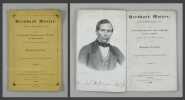
![Alberto Giacometti, photographed by Herbert Matter.. GIACOMETTI (Alberto)]. MATTER (Herbert).](https://static.livre-rare-book.com/pictures/VIG/103896_1_thumb.jpg)






